
Jaén, for whoever looks for it
By Antonio Zoido
We are travelling along the Route of the Nasrids. We reach Jaén as December is starting; we were getting there, although it appeared we are not, because while passing by the gorge that shatters castles, the city that was yet to come had neither been heralded nor announced. Kept for a long time on the margins of the growth of its province, Jaén was not a “latifundium” of residential areas. Just a short distance away from the urban conglomerate, whose whiteness had already begun to be spotted a while ago spreading down the slope, appeared some of those rosaries of houses on streets with fancy names whose resonances can be found rummaging in the vademecum of the medieval words that abound now everywhere.
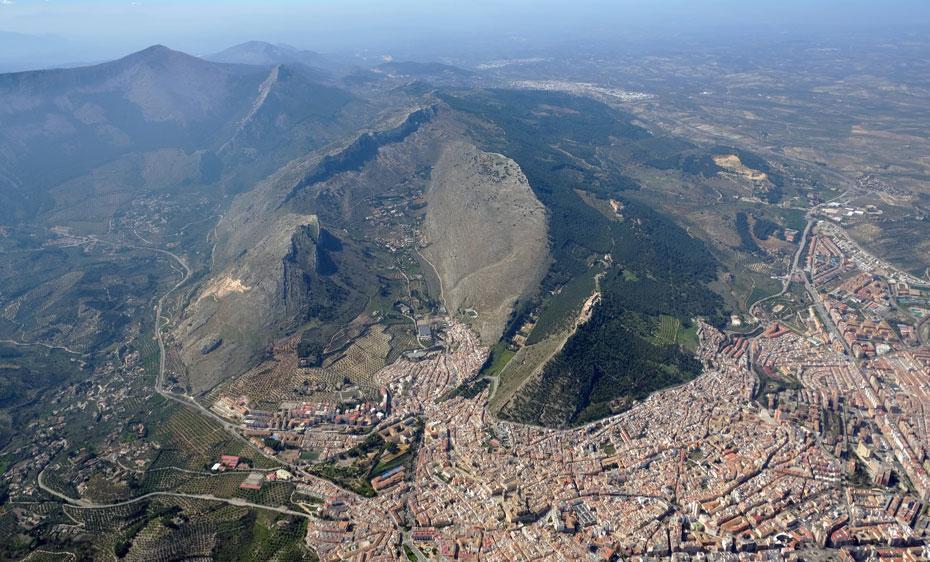
Next to Victoria Park, the streets filled with shops bustling with people carrying bags and, a little further, the Alameda that still preserves a traffic jam every Saturday.
Not far from the Puerta del Ángel, the monastery of the nuns of Saint Claire, who were called “las bernardas” as if they were Cistercians, and after having walked but a short way, the sun starts to spread over the collection of styles that the church of San Idelfonso boasts.
Separated from the oldest part of Jaén, confined almost to its outskirts during the Middle Ages, San Idelfonso later found itself in a better location than other churches and monasteries. The fact of hosting the image of the patron saint and the sepulcher of Andrés de Vandelvira made up the rest, including the gift of a façade by Ventura Rodríguez that imposed itself on the other two, respectively Gothic and Plateresque.
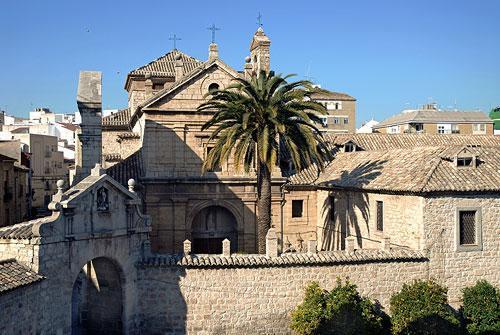
Puerta del Ángel and Convent of Las Bernardas. ©Andalucía.org
Modern Jaén intervenes; in the Plaza de la Constitución the elderly ones take in the sun and immigrant vendors sell what they can amid the gurgles of the fountains of the monument ̶ halfway between charming and kitsch ̶ built in honour of earthenware by Paco Tito. The way up to the cathedral through the square where the buildings of the Pósito (communal granary) and the Royo Real once stood is lined with houses and buildings that are themselves almost centenarian, filled with historicist and modernist elements and enclosed balconies, made long ago with great care.
Up there, in the misleading remoteness of mist, the stones, spires and towers of the cathedral can be envisaged, little by little becoming clearer; then, at the bottom of Travesía de Jesús, the flaneur can discover, if he looks up, the most beautiful corner by Vandelvira, its architectural orders arranged on different levels next to the door looking south, and the unique chapel.
The cathedral’s mass was set here, in the middle of today’s modern Jaén, more than five centuries ago, and the power of its stones swallowed up all that existed around and even beyond. Not even the city hall nor the bishop’s place can compete with it. The styles of architect Andrés de Vandelvira –the last mason-architect– erased the Gothic and Mudejar lines from San Idelfonso to the Magdalena; the real and true principle of the city that now has been left off-site.
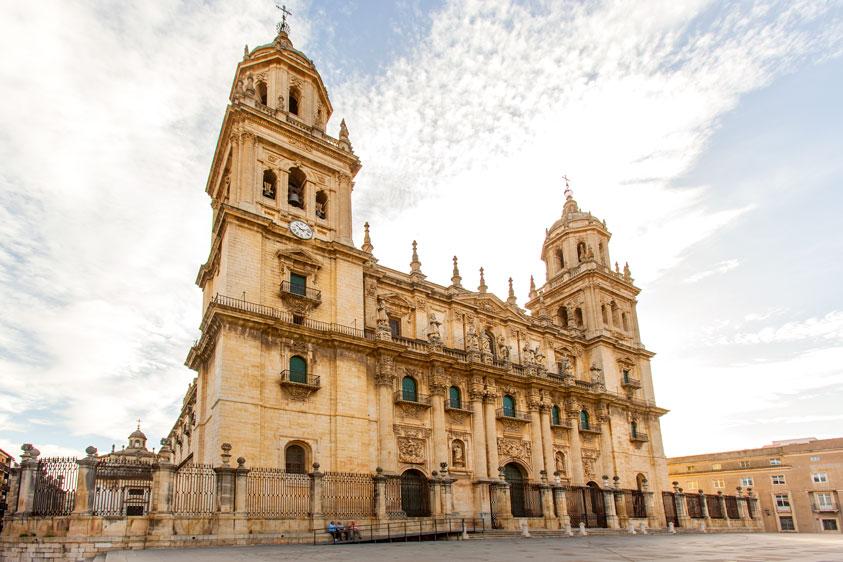
Cathedral of Jaén.
Separated from the oldest part of Jaén, confined almost to its outskirts during the Middle Ages, San Idelfonso later found itself in a better location than other churches and monasteries. The fact of hosting the image of the patron saint and the sepulcher of Andrés de Vandelvira made up the rest, including the gift of a façade by Ventura Rodríguez that imposed itself on the other two, respectively Gothic and Plateresque.
Off-site, but nearby, Maestra Street still does justice to its name. It leads, whoever may want to cross the stretch of shops to the primeval Jaén, full of splendid palaces, convents and hospitals that were inhabited ̶ something that any historic centre has today ̶ by people who also populates these streets, lanes and slopes, with scattered shops here and there, and some tavern where parishioners unfolded tales of hunters.
Almost alongside the Arch of San Lorenzo stands ̶ or better say, it stood ̶ the Palace of the Constable that centuries progressively transformed into many things, even a casino. The figure of the one who built it, Lucas de Iranzo, transcends it. There are characters who seem to be called to attract themselves to the covers of History and cities to which goddess Nemesis erases its golden days.
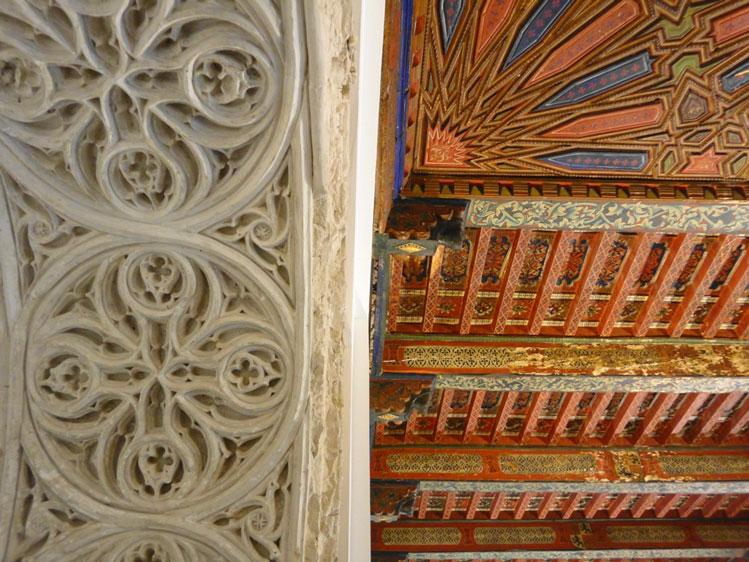
Palace of the Constable
From a plebeian origin, Lucas de Iranzo is, more than a lord, a condottiero —like Gattamelata or Colleone— but no Donatello or Verrocchio sculpted his statue. Attracted by his lavish parties, gypsies arrived to Andalusia from Constantinople; who knows if they were maybe the great-grand fathers of these toddlers who now climb the slope crooning tangos; In his chronicle we preserve the oldest account of a party of Moors and Christians and a kind of Auto de los Reyes Magos (“Play of the Three Wise Kings”) in which the very Lucas played dressed in the regalia of a caliph. That was the world Jaén lived in during the reigns of John II and Henry IV, when the money from his Jewish colony funded wars and soirées until intolerance raised its torches and daggers.
Torches reached the neighbourhood where we are now, and daggers stabbed the Condestable’s chest, while he was at mass it is said, and that those who wielded the daggers were old Christians irritated at the “protector of Jews”.
Maybe it was in the old church of San Juan, which still stands after having been refurbished by the fashions of every century and by negligence as well; and stuck to it, the Torre del Concejo (Tower of Council). Its bell called the neighbours to any important event, and in whose shade met the governing body of the city.
Below its apse spreads out the square ̶ popularly known as Pila del Pato ̶ which lords over the palace of Villardompardo and keeps in its subsoil the best witness of the Andalusí Jaén, the only baths with beautiful horse-shoe arches remaining in the city.
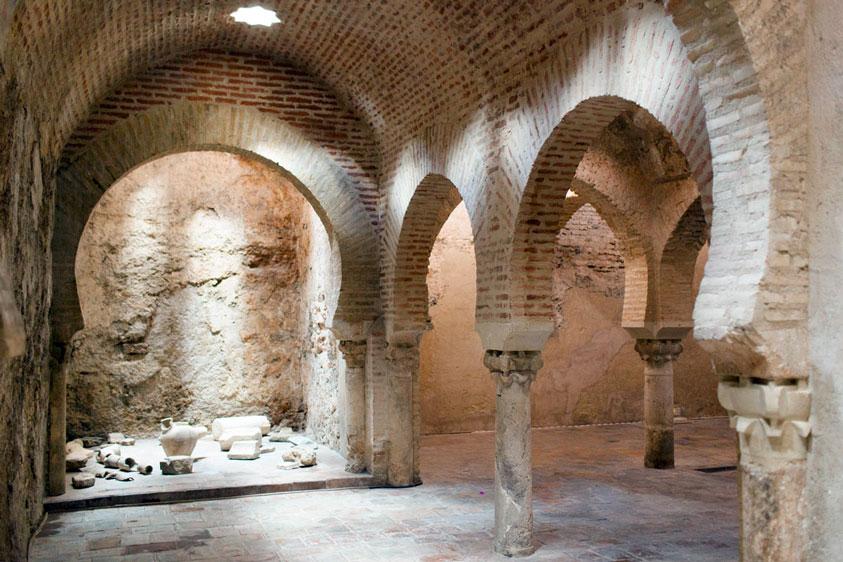
Arab baths inside the Palace of Villardompardo.
After all, this is the capital of the Holy Kingdom, and the remains of churches and convents almost seem to assault the passerby. Santo Domingo, for instance, still shows its somewhat gloomy power; today its severity is maintained to host the Provincial Archive, but before it was the headquarters of the Inquisition. According to the tourist brochures, it was the third oldest one in Spain, after Seville and Cordoba, but they forget Zafra, the “Sevilla la chica” (Little Seville), which has the questionable honour of being the second one in having such a dreaded tribunal.
The face of self-sacrifice is presented, a little further down, by the Brothers of San Juan de Dios in their hospital, which today has been turned into a civic and intellectual centre, after having gone through an exemplary restoration where old and new interweave in a natural way.
And, right next to it, the sweet face: Santa Ursula. In this convent, with almost five centuries under its belfry, people from Jaén buy the “come-and-go” sweets, the ones made of egg yolks brought from Cuzco by some women secluded in the convent.
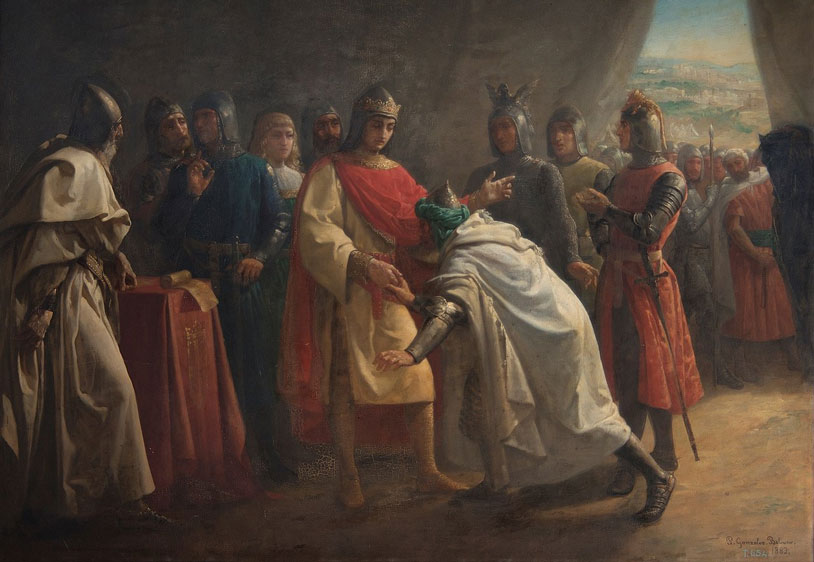
In the picture, a painting by Pedro González Bolívar (1883) at the Prado Museum in Madrid.
The founders of the Nasrid Dinasty were originally from Arjona, in the province of Jaén. Muhammad ibn Alhamar was proclaimed king of Granada in 1238 and he transferred the city of Jaén to Ferdinand II the Saint, with whom he entered an agreement recognising his vassalage.
As we keep on walking and walking, we reach the point where everything started: the stream of water that keeps flowing in a fountain right opposite the main door of the church of Magdalena, a fountain with the look of a Roman fontanone (fountain). In Jáen, the most popular urban legend is that of “the Magdalena’s lizard” whose dozens of varieties tells of the appearance of a monstrous animal that emerged from this fountain and devoured people until a prisoner achieved his freedom after killing the monster by making it eat gunpowder and then blowing it up. The monster could probably have been an alligator, but its fame raised the name of this church above all the rest.
Under the naves of the temple may remain still the foundations on which was settled the main mosque of Jaén until well after the arrival of Ferdinand III. The only remnants are the layout of the ablutions yard with some arches, from the same period, and a nearby tower; dated three centuries later. The beautiful Plateresque façade of the church lords over the rest remaining gates that look still magnificent, despite lingering in neglect. Andalusi times still echo from that tower to the Puerta del Aceituno, only few metres away. That was the full extent of the defensive wall, that hung down the citadel in the steep mountains.
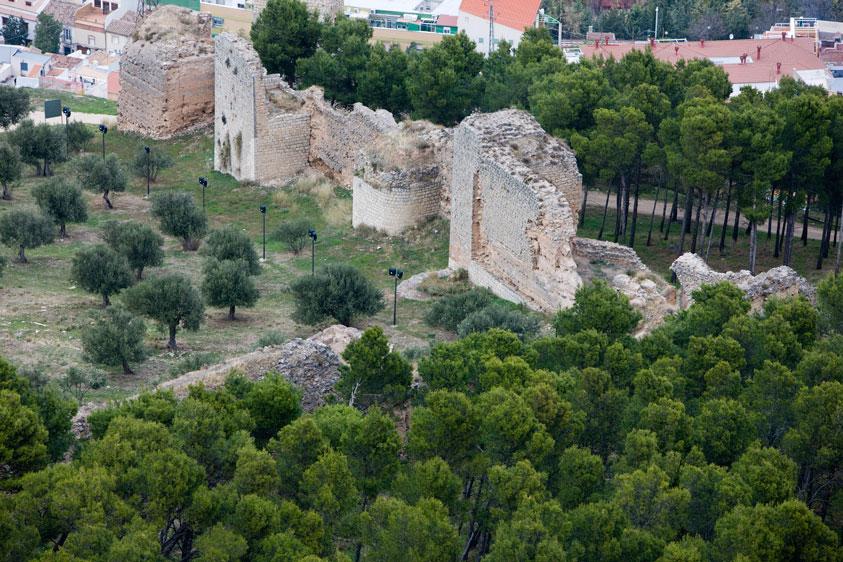
Walls of Jaén seen from the Castle of Santa Catalina.
Departing from the Adarves Bajos (Lower Ramparts) we have come up to cover, from the entrance of the Parador of Jaén, the rosary nearly 200 metres long that interlocks its towers, leading to the most beautiful lookout of the city, the one located at the foot of the cross where the wave of stone ends. From here, the cathedral looks like a model of itself.
The line of the Great Axis (with ambivalent resonances of both the urbanism of Le Corbusier and World War II) is cut by the railroad and the rooftops of the Provincial Museum that actually might be a universal one, as it hosts such masterful works as “The wolf of Huelma”, able to command on its own a mainstream like that of the Mona Lisa, but that is how life is.
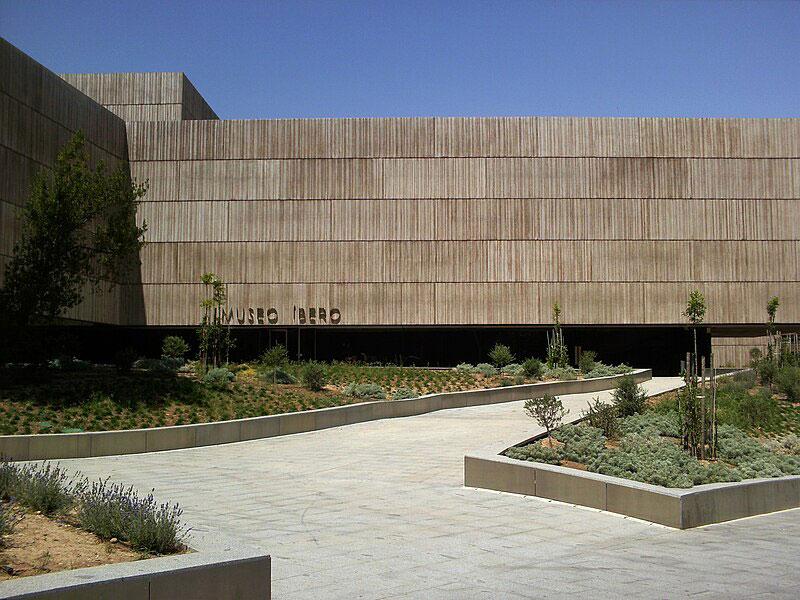
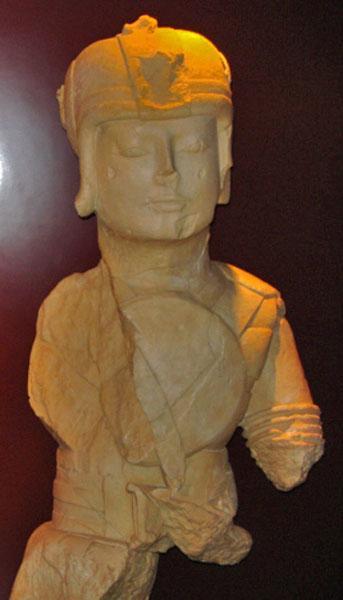
The “Warrior of Porcuna”. Iberian sculpture from the 5th century B.C discovered in 1975 at the archaeological site of Cerrillo Blanco (Porcuna, Jaén).
A little further up, in the plot site where the old prison once stood, now stands the Museo Íbero (Iberian Museum), said to be the crown jewel of that Andalusia that never knew from which sea its cultures came from and to where the exiles were banished. But that, as the owner of the coffee shop in the movie Irma La Dulce said “is another story”; that of the Iberians that, like the one of the Condestable, is only in Jaén for whoever looks for it.
